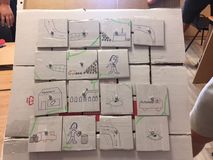
The Cycle of Recycle
Game details
Do you see any offensive content? Do you suspect a violation of intellectual property? Don’t hesitate and let us now. We need your support in keeping this platform safe and trustworthy. Our StreetSmart staff will review all reported games and users two times per week and will evaluate if they violate our terms and conditions.
 This game was automatically translated from Greek.
View in original language.
This game was automatically translated from Greek.
View in original language.

Step 1
1. Polar Bear
This animal is the largest species in its class. It is white in color and lives in the Arctic. Its weight reaches 650 kg. It is in great danger because of climate change as the Arctic ice on which it finds its food melts. Due to global warming, they are becoming finer and fragile, forcing them to swim to more distant areas to find food and spend even more energy, which means they need even more food. This results in them moving to other areas, even on land, desperately searching for food. Often, he searches for goose eggs or searches for garbage can in distant cities.
2. Residents of Pakistan
Climate change in many parts of the country has brought about extreme weather events such as floods and heatwaves. The Gilgit-Baltistan area has been hit in recent years by torrential rains, sudden floods, and landslides, and monsoon and snowfall periods have changed. These conditions make living dangerous and force the locals to move, leaving their homes and property behind.
3. Northern Leopard Frog (Leopard Frog)
He lives throughout North America and stands out from the color and irregular patterns of his skin that refer to a leopard. It is of medium size, omnivorous, and since 1970 its population has declined markedly in Canada, both in the countryside and in the mountains. The main reasons for its gradual disappearance are the pollution of their natural habitat, deforestation and the increasing acidity of water.
4. Monarch Butterfly
It weighs about one gram and yet travels even 80.5 kilometers a day. The trip is a group trip, starting in Canada or the US and ending in either Mexico or Santa Cruz. It is drawn from the trees used by its ancestors last year and sits in groups on the same trunk. So whole forests are covered by it and the greens turn orange. It takes about 4 generations to complete a whole cycle of migration from North to South and vice versa. His DNA states his destination and the journey to survive. Climate change and the loss of its natural habitat threaten its survival. Increasing levels of carbon dioxide make its unique food - the Milkweed plant toxic, while rising temperatures cause it to migrate further north than before, making its journey more difficult and dangerous.
5. Siberian brown bear
It lives in areas of the Altai Mountains of Mongolia, southern China, eastern Kazakhstan and the Siberian taiga (northern forest). More than 16,000 animals of this species live in eastern Siberia, and feed on fruits, fruits, fish and small mammals. After the deadly fire in Siberia (2019), they seek refuge and food in the nearest towns and villages as their natural environment is burning.
6. Penguin Adelie
He lives mainly on the coast of the Antarctic continent. He lives in the summer on land and in winter he migrates by swimming to the sea ice, where he chases for food. Rising water levels limit the amount of fish - and therefore its food - while ice melts and rains destroy the nests where its eggs lay. Also, newborns who are not yet waterproofed are dying of hypothermia due to the rain. Thus, where sea ice disappears, this particular species cannot survive, and is forced to migrate to Amundsen Seas wildlife refuge where there is a glacier.
7. Refugees from the Juruna tribe, Brazil
People of this tribe live on the mouth of the river Xingu, in the Amazon basin. The water level of the Xingu River results from climate change and severe weather and has worsened with the construction of a dam in 2016. Since then, large areas of the area where this particular tribe lives have been covered by water, forcing people to relocate.
8. Red knot- shorebird (coastal bird)
It migrates to the Arctic (area around the North Pole) to breed and feed on insects that hatch in the springtime when the ice melts. However, with global warming, insects hatch before spring and when it reaches the Arctic, it has no food to feed itself or its young. He often returns from where he started, namely West Africa, which has more insects, but newborn bears cannot extract insects from the African sand and thus cannot feed.
9. American Lobster
The heaviest shellfish, up to 65 points and 20 kg. It feeds on starfish, mussels, sea urchins and other sea creatures. Global warming has brought about changes in the Atlantic Ocean ecosystem and has caused the migration of many marine species, including this one. As ocean temperatures rise, this species, which can only survive in cold waters, has moved 500 miles north of the Long Island coast, where it lived, to the northern coast of Maine.
10. Caribou (Rangifer Tarandus)
A species of mammal belonging to the deer family, it looks very much like a reindeer but is much smaller in size and is disappearing. Each spring it migrates to West Greenland to breed and feed on spring blooming plants. But with global warming, temperatures in West Greenland are rising before spring, when plants and flowers bloom earlier, and as the season arrives, there is no longer enough to feed itself and its babies. Thus, few of these animals born each spring in Greenland manage to survive.
11. African Elephant
He lives in the African continent, is a durable and adaptable animal, and can survive in various parts of Africa. The biggest problem that threatens its survival is the increase in temperature and drought that reduce the amount of fresh water in the living areas. Lack of water makes it difficult to survive and reproduce, while forcing it to migrate from region to region in search of fresh water, traveling vast distances with the risk of its life.
12. Siberian tiger
It ranks among the largest feline ever. It has developed some natural adaptations to withstand the cold climate of its habitat, such as a thick layer of fat and a very dense fur and is a sarcophagus. It is now threatened with extinction, as the dense forests that make up its natural environment disappear due to deforestation and deforestation. According to the International Union for the Conservation of Nature, this species is in danger of extinction.
13. Families of refugees in Sudan
Climate change in this area is causing desertification of the countryside. Changes in the environment burden the majority of people in the agricultural sector. Unsustainable consumption of natural resources combined with changes in the environment (increased drought periods, heavy rainfall and floods, etc.) deplete natural resources. Survival thus becomes more difficult for residents as disputes and conflicts over the exploitation of natural resources and refugee flows in search of water and arable land increase. Many areas become unsustainable as they become deserted by drought or affected by floods.
14. Panda
One of the most recognizable animal species on the planet because of its unique appearance. It feeds exclusively on bamboo (a plant species) and once lived in bamboo forests of China, Vietnam, Laos and Myanmar (Burma), and now lives only in the forests of China. The most important reason that is at risk is the disappearance of its habitat, that is, its natural environment. As bamboo forests diminish, it is not possible to move around in search of another forest, as there are cities between forests and this species cannot survive in an urban environment. It is now estimated that some 1800 animals of this species are alive.
15. Marimanda Monkey - Spider
It lives in the Brazilian Amazon Basin, in the Rio Tapajós and Rio Tocantins areas, and can be found on the highest peaks of rainforest trees. It mainly feeds on fruits, but also on plants, seeds and small insects. Because of their dietary choices, they play an important role in their ecosystem as they disperse the fruits and plants they consume in their moving areas. According to the International Union for the Conservation of Nature, this species is at risk of extinction as the forests in which it lives are deforested and converted into soybean plantations.
16. American Hare
He lives in the Rocky Mountains of Canada. In summer it feeds on grass, leaves, and ferns, while in winter it feeds on branches, tree bark, etc. In order to be able to hide and protect the hunters, his hair becomes brown in summer and white in winter. The change in his hair depends on photoperiod, that is, his adaptation to the relative duration of the light and dark periods of each season. In winter when the time of day is reduced his hair turns white, and in summer it becomes brown. Due to climate change and global warming, in winter when its color turns white there is not enough snow to hide from its predators, which is a very significant threat to its survival.
17. Residents of New Jersey, USA
In 2012, Hurricane Sandy began in the Caribbean and reached New York, causing untold disasters. In New Jersey alone, losses of about 17 billion were caused. dollars, 150 people lost their lives, 600,000 homes destroyed, and to date over 1,000 residents have not been able to return to their homes and most of them have moved further off the coast. Increasing sea levels as well as rising water temperatures make coastal areas more vulnerable to such natural phenomena. The upper layers of cold water that disappear with global warming act as a barrier, preventing the creation of hurricanes caused by the warmer layers of water. Since 1970 there have been 6 equivalent hurricanes in America, which have cost lives, created climate refugees and material catastrophes.
18. Whale blower
She lives in herds, in tropical and subtropical seas. It has a cylindrical tip, a huge head and swims fast. When it emerges on the surface it blows with great force the air and water vapor from the unique nostril that carries on its nose, forming a jet. Its food includes squid and fish. Contamination with plastics is a huge threat to this species. It consumes involuntary plastic items that are trapped in his stomach and take up space limiting the amount of food he can consume. At the same time, in an attempt to break down plastics such as food, its digestive system secretes multiple amounts of gastric fluid to the extent that it destroys the tissues of its skin. The amount of plastic trash that ends up in the sea has tripled since 1960, while floating plastic trash in the Pacific Ocean occupies an area of 620,000 square miles.
19. Green sea turtle
It lives in tropical and subtropical seas, is a vegetarian and feeds mainly on seaweed and seaweed. As the place of birth is imprinted in his memory, he always returns to give birth in the same place. Thus, when beaches are lost due to rising sea levels, the process of birth and incubation of these animals is disrupted. Also, the higher temperature of water and sand affects the sex of newborns that are incubated resulting in the incubation of female turtles, creating a major problem in their reproduction. Finally, the coral reefs that make up their natural habitat are threatened with extinction, making it difficult not only for their reproduction but also for their survival. In the Philippines, there is a cluster of islands that has been designated a shelter for this particular species (turtle islands) since 1996.
20.Zone-dolphin - Stripped dolphin
It lives in all the seas of Greece, both in deep waters and near the coast. An isolated population of this species lives in the Corinthian Gulf. It gets its name from a black stripe on the top of his body. She is small (up to 1.65 m long) and is a keen swimmer. It feeds on squid, and small sea fish such as sardines. Adult at 11-12 years and reproduces every 3 years. It is endangered by marine pollution, accidental capture of fishing gear, overfishing, which causes food shortages, and its deliberate killing. Since 2019 it has been among the endangered animals in Greece.

Their questions and difficulty may vary depending on the age of the players.
The game can be adapted to Mobile School with the help of magnetic panels
World Map and replacing the pawns with bottle cups.

Vicky Konstantinidou
Project Coordinator Ladies Union of Drama GR
12 September, 2019
Very interesting game! Can't wait to implement it with my team ^_^
Don’t hesitate, share your feedback and help others to pick the right games. Tell us how it was and how the children reacted? Or do you have any advice for other players, a fun variation, a possible improvement?
![]()
We very much appreciate your effort in writing the review.
You can change these settings at any time in your Cookie-preferences . You can also view our Privacy policy .
Cookies saved

